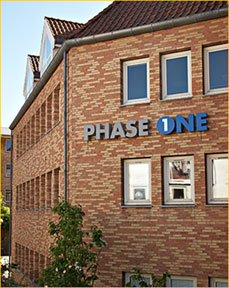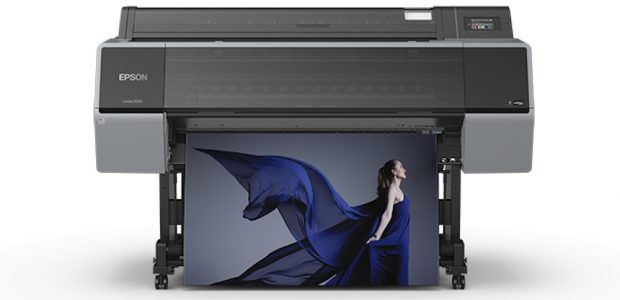Phase One is one of the oldest companies making professional digital image capture devices. Note that I haven’t written cameras, instead of using a more awkward phrase, because Phase One makes digital backs for medium format and large format camera systems rather than actual camera bodies. Therefore, photographers are free to choose the camera and lens system that appeals to them the most, or which they may already own, and then choose a back that meets their needs and budget. Phase is a Danish company, headquartered in Copenhagen on the outskirts of town and close to the zoo. In June of 2005 I had an opportunity to visit their head office and factory. I was on my way to Norway to do a landscape shoot, and was accompanied on both trips by my friend Kevin Raber, who is Phase One’s VP of Sales and Marketing for North America. It was he, obviously, who arranged our visit to the company.

Disclaimer
Because readers are naturally always curious, or suspicious, or both, of writers who review products and interview companies, I’d best start this off with a clear exposure of my relationship with both Kevin and Phase One. In addition to his role as a sales executive for Phase, Kevin is a friend. He is also an avid landscape and nature photographer, and we have been traveling and shooting together on a number of occasions. I own a Phase One P25 back, which I purchased at retail in 2004.
By way of full disclosure – Phase One did buy us a very nice dinner while we were in Copenhagen. In addition to dinner I also received as a gift from the company, a t-shirt, as well as a plastic coffee mug embossed the Phase One logo. With that said, Chris Sanderson and I paid 100% for our trip to Europe, as well as our hotel and all other expenses associated with the visit to Phase One.
The Video
The purpose of our visit was to film interviews with various members of the Phase One management team for an upcoming issue of The Video Journal. These interviews, as well as a close-up look at how these products are designed and built, will appear in Issue #13 of The Video Journal, scheduled for release in the second half of 2005.
This write-up is simply an overview and a “teaser” of what we saw and learned during our two-day visit. If you’re interested in learning more about these cutting-edge devices you may want to consider subscribing to The Video Journal. (Yes – this is a blatant sales ploy to get you to subscribe).

The Facility
Phase One’s head office and manufacturing are located in a three-story office complex of typical Danish design (seen above in Figure 1). There are many aspects that remind me of California high-tech companies, such as a foosball game in the staff lounge, along with catered lunches for staff. There didn’t appear to be any private offices, with everyone from Vice Presidents to marketing and support staff sharing open spaces. The work environment seemed to be equal parts California and Europe, a fascinating combination. The dress was very casual, and I didn’t see a single suit or tie. The Copenhagen office houses approximately 75 people, with another 25 or so staff located in offices elsewhere in Europe, the US, and Asia.
The Open Kimono
Over the past 35 years, I have done business extensively with North American, European, and Asian companies. (I have had a career in several high-tech industries, as well as a photographer). If I had to rank companies in their willingness to openly discuss their products, business plans, and their competitive environment, I would have to rank Americans as the most open, followed by the Europeans, and then Asians. But Phase One is from another mold altogether. We had almost complete access to the company’s facilities, including manufacturing, engineering, product development, and marketing. This included not only walk-throughs of all the facilities but the opportunity to chat with employees, from the CEO to assembly line workers.
Manufacturing
From a visual point of view, the most interesting aspect of the visit was the manufacturing facility. The first thing that one is aware of (because otherwise, they won’t let you in) is the strict attention to anti-static measures. Special smocks and ground straps for one’s shoes are de-rigeur.

Approximately a dozen people are involved in the final assembly of the camera backs. The actual boards are manufactured elsewhere under contract, based on Phase’s original designs. Once the completed boards and sensor chips are in-house, assembly and testing of each back takes four people about 10 hours, spread out over roughly a 10 day period.
This is meticulous hand assembly. No automated assembly line…simply skilled hands and eyes carefully putting each component into place and testing and retesting each step of the way.

I was very curious to ask about the huge sensor chips that are used in making these backs. Current Phase One backs use chips from Kodak, though Dalsa chips have been used in the past, and may again in future.
The 16MP and 22MP chips used in the current H (tethered) and P (self-contained) backs represent a very significant proportion of the cost of these products. No one at Phase One, or any other back or chip maker for that matter, will comment on the record about what these chips cost, but a good source told me about a year ago that a 22MP chip then cost back makers approximately US $4 – 5,000 each. This goes a long way toward explaining the high cost of medium format backs.
According to Jesper Sandagar, Phase One’s VP of Manufacturing, chips from Kodak currently have a 93% acceptance rate. This means that after testing for use in Phase One backs, 7 out of every 100 are rejected. Phase One’s criteria for acceptability are such that a typical chip will only have on average between 200 and 300 bad pixels out of 22 million. This represents an acceptable defect rate of 0.000009%. Bad pixels are, of course, mapped out as part of an exhaustive calibration process, and a custom “profile” of the precise characteristics of each individual chip is then burned into a supporting ROM chip. This data is then used while generating the RAW files that are saved to the back’s memory card or attached computer. This is typically about one Megabyte of calibration data and is derived from roughly a Gigabyte of testing data that is generated for each chip. It takes a technician about 90 minutes to calibrate and profile each sensor chip. This database is stored at Phase One, and if there is ever any question about the chip’s performance its original calibration data can be examined at a future time.

I asked Jesper if to his knowledge there was such a thing as a sensor chip deteriorating over time. His answer was an unequivocal no. No amount of exposure to light has any effect on a sensor. Apparently, there are Phase One backs currently being used in aerial mapping that have seen well in excess of one million exposures, and which show no sign of sensor wear or deterioration.

A clean room is used for the addition of the infrared blocking filter. These highly precise filters are cleaned by hand to ensure that both the sensor cover plate and the filter itself are absolutely free from dust. Phase One backs do not use an anti-aliasing filter, maintaining the sensor’s maximum resolving power.
The Future of Medium Format Digital

Medium format digital is alive and well today, but, what about the future?
Henrik Hakonsson is the President and CEO of the company and a remarkably outspoken executive. In our on-camera interview, he talks extensively and very candidly about the possible future of his industry.
Henrik has real concerns – primarily about the makers of medium format cameras themselves. We have seen the demise of Bronica and Contax, and there are well-known concerns in the industry about the financial well-being of several of the other players. Could we indeed see a time, possibly in as little as a year or two, when there is only one or at most two camera makers left?
There is no question that medium format digital has a bright potential if at least a couple of camera makers can remain in business. Higher resolution backs are on the way, as are some very exciting technical innovations. But, these will only find their way into commercial backs if the medium format industry as a whole can survive.
Currently, there is considerable turmoil. Leaf now finds itself owned by Kodak, because they were part of that company’s acquisition of Creo. Since Kodak just got out of the medium format back business themselves last year, and their remaining DCS cameras earlier this year, it would appear likely that Kodak will not want to hang on to Leaf, or at least commit any serious development money to this business segment.
Pentax is still at least a year away from having a medium format digital product, and even then this will be a closed system. Mamiya has experienced considerable technical delays in getting its ZD body and backs to market, and it is rumored in the industry that Mamiya’s financial situation is cause for some concern. Several industry players have been trying to work with Kyocera and Zeiss to resurrect the Contax 645 line, but as of June 2005, when this is being written, this future also remains unclear.
That leaves Hasselblad and Imacon, or Hasselcon, as some now call it. While Hasselblad was independent they worked closely with third party back makers. Indeed much of the H1’s digital interface was reportedly developed in cooperation with Phase One. But now, I’m told, cooperation between Hasselblad and other back makers has soured, and there are signs that the company may be moving in a proprietary direction with regard to digital backs for use on its camera bodies.
There is one other player, Eyelike and Sinar, which now have merged their destinies to a large extent. But given that Sinar also appears to be laying off staff, and Eyelike’s penetration of most major markets has not been strong, one really has to wonder about the future of all of these companies and brands. Will the end-game of this industry segment be a matter of the last man standing?
When we spoke Henrik was guardedly optimistic. While he sees continued consolidations, he is confident that Phase One, which currently commands more than 50% of the worldwide medium format back market, will be among the survivors.
A video tour of the Phase One facility in Copenhagen along with interviews with that company’s senior product development, manufacturing and marketing executives will appear in Issue #13 of The Video Journal in the second half of 2005
You May Also Enjoy...
Keet Seel
A Remembrance of Things Present©Miles HeckerCLICK ABOVE IMAGE TO SEE GOOGLE MAP LOCATIONSEASONS In Navajo,Keet Seelmeans "broken house". Keet Seel was built in a branch
How large is your printer? (does the difference between 45 and 60 MP really matter)
FacebookTweet There have been many breathless articles in the technology press lately about how the Sony A7r IV is the “best camera for this or

